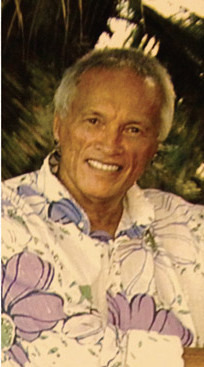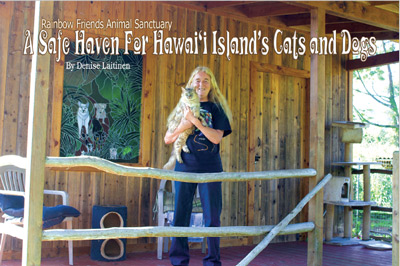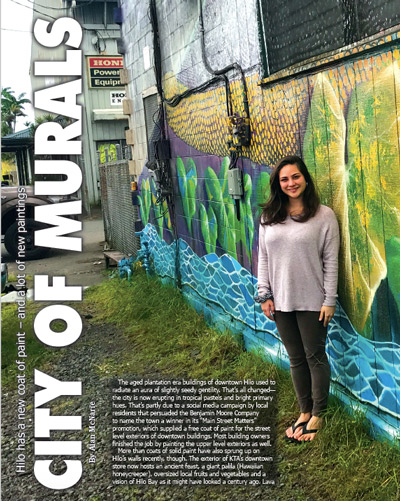Resilience is the New Sustainability
By Michael Kramer
It’s been 30 years since the United Nations Bruntland Commission put sustainability on the global map of consciousness. Has it taken hold here in Hawai‘i? Ten years ago, Hawai‘i created the Hawai‘i 2050 Sustainability Plan, which involved 10,000 people throughout the state in articulating goals to improve our lives in areas such as jobs, housing, education, health care, culture, and the environment. The results of the public opinion polls then indicated that 80% of the population viewed sustainability and the “triple bottom line” for business as key to Hawai‘i’s future. Specific priorities identified were local food, renewable energy, water conservation, recycling, green business, and biodegradable products.

Since that time, the world as we know it has changed considerably: the effects of climate change have been astonishing, with additional threats looming, especially for coastal areas; economic inequality has exacerbated; radical political thought and policies on the left and right have emerged; the cost of living in Hawai‘i continues to increase; and social justice and sustainable living have become quite mainstream, including on this island.
One could argue that in the 30 years since sustainability first emerged that it has finally taken hold in Hawai‘i. But the question remains, does it go far enough? The embrace of sustainability’s tenets has largely been slow and gradual, even though the trend has been positive. Do we have enough time to continue to progress slowly in this regard? Moreover, given that the future is volatile and highly uncertain; would it not be prudent to prepare for a variety of possible future scenarios that may affect us at both the personal and community level?
It is for this reason that resilience may be the new sustainability as an organizing principle for how to live on this island. Whether you’re a Doomer or a Dreamer or somewhere in between with your worldview, it seems prudent to be ready for anything, because we can’t foretell the future. However, it is clear that we are quite vulnerable here in the middle of the Pacific, where imports prop up our society, and as such the affects of sea level rise and severe weather can have significant impacts on our capacity to import goods from elsewhere and thrive. This only further illustrates the imperative of island self-reliance.
As such, it is critical that we focus on ways to produce more of what we need to survive here rather than expect the supply lines to be maintained without disruption. For the past 10 years, this has spawned great interest in island self-sufficiency in key aspects of our lives: food, water, energy, and shelter. While the state and local government have taken this challenge seriously, it remains to be seen whether or not the private sector and the general public will also take these issues seriously. Most people don’t change their behavior unless forced to do so, so planning ahead isn’t an automatic disposition for most people, however that doesn’t negate the importance of continuing our island’s path towards a regenerative way of life.
Let’s look at our island’s recent progress in sustainability efforts. In 2012, according to the county food self-sufficiency baseline study, estimates were that Hawai‘i Island produces roughly 95% of the fresh milk, 17% of the fresh beef, 51% of the seafood, 34% of the vegetables, and 32% of the fruit consumed on the island.
In actuality, not much has formally changed with these statistics in the past five years, but initiatives are underway to address that. Investment group Ulupono Initiative, launched by eBay founder Pierre Omidyar, has invested over $60 million on Hawai‘i Island alone in agriculture, aquaculture, and energy waste recovery in endeavors such as ‘Ano‘ano Farms, Paniolo Cattle Company, BioEnergy Hawaii, Blue Ocean Mariculture, and the Hawai‘i Island School Garden Network.
Meanwhile, a lot of the innovation is coming out of North Kohala, which is the only district on the island to have declared a goal of 50% food self-sufficiency. Hawai‘i County, for example, helped support The Kohala Center in launching the Hawai‘i Food Producers Fund using the Kiva.org peer-to-peer lending platform, which allows local residents to crowdfund local farmers up to $10,000 for three year terms at no interest. The Kohala Center also created a Beginning Farmer-Rancher Development Program to train new farming families in the Hāmākua district to create viable jobs and businesses for the younger generation.
The County also supported Kahuā Pa‘a Mua’s Kohala Swine Integrated Project, a youth run micro-enterprise project that uses the natural farming method to create businesses raising pigs in an environmentally conscious way.
The Kohala Institute, meanwhile, is in the process of restoring the 2400 acres of ‘Iole to a functioning ahupua‘a (land division) system, where three vegetable, kalo, and fish farms are attempting to demonstrate the sustainability and viability of local food production in one ecosystem.
HIP Agriculture provides an in-depth residential Farm Training program on its 7-acre permaculture farm near Pololū Valley, while the Hawai‘i Homegrown Food Network has been facilitating a Ho‘oulu ka ‘Ulu (Revitalizing Breadfruit) for several years, primarily by harvesting wild ‘ulu in West Hawai‘i and helping develop consumer and restaurant interest in the crop along with incubating value-added products. An integrated farm hub, Hamakua Harvest, is under development in Honoka‘a, while the Kohala Village Hub is fast becoming a center for food, arts, ecology, and culture.
On the energy front, when the Hawai‘i County Energy Sustainability Plan was passed in 2012, 46% of the island’s energy was generated from renewable sources. Today, we’re closer to One of the Hawai‘i Island School Garden Network programs. photo courtesy of Nancy Redfeather 50%, and Hawaiian Electric is still seeking a provider for an additional 50 MW of geothermal power for the grid. Meanwhile, the Natural Energy Laboratory of Hawai‘i is developing a 1 MW Ocean Thermal Energy Conversion plant, and Big Island Biodiesel is producing over 5 million gallons a year of biodiesel, which is half the demand for diesel fuel on the island.
Our County government has been leading the way in sustainability in its own operations. In the past five years, the county has:
- Installed a 3 MW wind farm for the Department of Water Supply, expected to save ratepayers up to $1 million/year
- Installed 12,000 LED street lights and 1000 LED lights in county facilities, delivering savings of up to another $1 million/year
- Shifted its vehicle fleet to electric vehicles and biodiesel, and installed 50 electric vehicle charging stations
- Through energy efficiency performance contracts, the county is also expected to save over $8 million over the next 10 years in utility costs for its facilities
The County is currently working to develop a hydrogen fuel production facility and intends to power public buses with this clean fuel, and it is facilitating installation of another 7,000 LED street lamps installed at parks, homeowner’s associations, resorts, and shopping centers.
In the realm of green building, several significant LEEDcertified projects have been completed in recent years, including the Hawaiian Language Building at UH-Hilo and the State base yard in Kona.
In the realm of green business, the Kona-Kohala Chamber of Commerce remains the only chamber in the state to offer a recognition program for members who set high standards of integrity, commitment and respect in their engagement with employees, customers, community, and the environment. Its Kuleana Green Business Program, which I founded 11 years ago require businesses to demonstrate ethical and sustainable policies and procedures to earn kuleana status.
These are only a few examples of some of the important and innovative sustainability initiatives happening on Hawai‘i Island. Of course, the simple truth is that everyone can adopt new practices that contribute to a regenerative island lifestyle. Through our actions, and through our advocacy ad expectations of business, educational institutions, government, and the nonprofit sector, we can all accelerate the adoption of sustainable approaches on Hawai‘i Island through a variety of activities:
- Buy from locally-owned businesses, as money spent this way circulates more on island before leaking away, which creates jobs here
- Shop at businesses that take good care of employees, customers, the community and the environment
- Save money in local financial institutions such as credit NELHA’s Ocean Thermal Energy Conversation facility. photo courtesy of Laurence Sombardier unions—the money is loaned only to on-island members, which grows local businesses and does not support unsustainable enterprises
- Invest in local businesses. Participate in the island agriculture microloan programs or form a hui (organization) and support other worthy businesses using sound due diligence processes (examples can be found at local-investing.com)
- Join Hawaiian Ola, Hawaiian Legacy Hardwoods and Natural Investments as Hawai‘i Island Certified B Corps, beneficial corporations meet rigorous social and environmental operational standards akin to LEED standards (bcorporation.net)
- ncorporate in Hawai‘i as a Sustainable Business Corporation, thereby agreeing to operate in the interests of the community and environment as well as the owners (sahawaii. org/p/sustainable-business-corporation.html)
- Join the Kona-Kohala Chamber of Commerce’s Kuleana Green Business Program
- Participate in efforts to establish food and energy independence, either at the home, neighborhood, or community level
- Embrace a meaningful career or volunteer service that makes a positive difference to the people and environment of this island
- Shop from socially and environmentally conscious corporations. Check out GreenAmerica.org and GoodGuide. com for a helpful app that rates major companies along these lines
- Advocate for the preservation of natural ecosystems through the county’s set-aside of 2% of revenue from property taxes to purchase sensitive and important lands for public access and use
- Develop a strong social network that can be tapped in case of natural disasters or other physical or financial disruptions in your life
- Participate in community events and civic affairs, letting your elected officials know how you feel about your priorities; and
- Remember that on a spiritual level, that we are all connected, and that all our actions on this island affect one another.
Creating a resilient way of life based on the principles of sustainability requires that we expand our way of thinking to be ready for any possible future scenario, and in a way that there is simplicity about living consciously and integrating the ethics of caring for people and the environment in everything we do. If we wish to thrive as an island society, our priorities need to focus on growing the local green economy to assure a reliable supply of what we need to survive.
Contact writer Michael Kramer: michael@naturalinvestments.com


